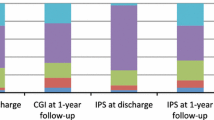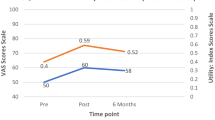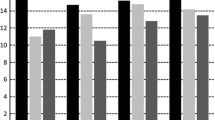Abstract
Introduction
Neurological rehabilitation aims to improve quality of life of patients with acute and chronic neurological conditions. Much of the existing research focuses on the impact of rehabilitation on physical functioning, with less emphasis on emotional wellbeing. This study assessed changes in psychological functioning in patients on discharge from rehabilitation and three months after discharge.
Methods
Patients admitted over a six–month period to a neurological rehabilitation unit were recruited prospectively to this study. Psychological functioning was measured by the self–report General Health Questionnaire and the Hospital Anxiety and Depression Scale. In addition, physical functioning was measured by the Barthel index and Functional Independence Measure.
Results
Psychological functioning was found to be significantly improved with rehabilitation. However, after three months, patients’ scores returned to pre–treatment values. Anxiety was consistently elevated on admission, discharge and follow–up. In contrast, physical functioning improved from admission to discharge and was maintained at follow–up assessment.
Conclusion
Rehabilitation services need to focus more on psychological functioning after discharge and identify effective strategies to maintain wellbeing.
Similar content being viewed by others
References
Andresen EM, Vahle VJ, Lollar D (2001) Proxy reliability: health–related quality of life (HRQoL) measures for people with disability. Qual Life Res 10:609–619
Bridges KW, Goldberg DP (1986) The validation of the GHQ–28 and the use of the MMSE in neurological in–patients. Br J Psychiatry 148:548–553
Cohen J (1992) A Power Primer. Psychol Bull 112:155–159
Collin C, Wade DT, Davies S, Horne V (1988) The Barthel ADL Index: a reliability study. Int Disabil Stud 10:61–63
Dalos NP, Rabins PV, Brooks BR, O’Donnell P (1983) Disease activity and emotional state in multiple sclerosis. Ann Neurol 13:573–577
Dillman DA (1978) Mail and telephone surveys: the total design method. Wiley, New York
Feinstein A, O’Connor P, Gray T, Feinstein K (1999) The effects of anxiety on psychiatric morbidity in patients with multiple sclerosis. Mult Scler 5:323–326
Freeman JA, Langdon DW, Hobart JC, Thompson AJ (1997) The impact of inpatient rehabilitation on progressive multiple sclerosis. Ann Neurol 42:236–244
Freeman JA, Langdon DW, Hobart JC, Thompson AJ (1999) Inpatient rehabilitation in multiple sclerosis: do the benefits carry over into the community? Neurology 52:50–56
Freeman JA, Playford ED,Nicholas RS, Thompson AJ (1996) A neurological rehabilitation unit: audit of activity and outcome. J R Coll Physicians Lond 30:21–26
Freeman JA, Thompson AJ (2000) Community services in multiple sclerosis: still a matter of chance. J Neurol Neurosurg Psychiatry 69:728–732
Gillen R, Tennen H, McKee TE, Gernert–Dott P, Affleck G (2001) Depressive symptoms and history of depression predict rehabilitation efficiency in stroke patients. Arch Phys Med Rehabil 82:1645–1649
Gold SM, Schulz H, Monch A, Schulz KH, Heesen C (2003) Cognitive impairment in multiple sclerosis does not affect reliability and validity of selfreport health measures. Mult Scler 9:404–410
Goldberg DP, Hillier VF (1979) A scaled version of the General Health Questionnaire. Psychol Med 9:139–145
Gompertz P, Pound P, Ebrahim S (1994) A postal version of the Barthel Index. Clin Rehabil 8:233–239
Granger CV, Hamilton BB, Keith RA, Zielezny M, Sherwin FS (1986) Advances in functional assessment for medical rehabilitation. Topics Geriatr Rehabil 1:59–74
Guyatt GH, Feeny DH, Patrick DL (1993) Measuring health–related quality of life. Ann Intern Med 118:622–629
Hobart J, Lamping D, Thompson AJ (1996) Measuring disability in neurological disease: validity of the self–report version of the Barthel index. Eur J Neurol 3:122–123
Hobart JC, Freeman JA, Lamping DL (1996) Physician and patient–oriented outcomes in progressive neurological disease: which to measure? Curr Opin Neurol 9:441–444
Hobart JC, Lamping DL, Freeman JA, Langdon DW, McLellan DL, Greenwood RJ, Thompson AJ (2001) Evidence– based measurement. Which disability scale for neurologic rehabilitation? Neurology 57:639–644
Hopman WM, Verner J (2003) Quality of life during and after inpatient stroke rehabilitation. Stroke 34:801–805
Johnson G, Burvill PW, Anderson CS, Jamrozik K, Stewart–Wynne EG, Chakera TM (1995) Screening instruments for depression and anxiety following stroke: experience in the Perth community stroke study. Acta Psychiatr Scand 91:252–257
Jorger M, Beer S, Kesselring J (2001) Impact of neurorehabilitation on disability in patients with acutely and chronically disabling diseases of the nervous system measured by the Extended Barthel Index. Neurorehabil Neural Repair 15:15–22
Kazis LE, Anderson JJ, Meenan RF (1989) Effect sizes for interpreting changes in health status. Med Care 27:S178–S189
Loong CK, Kenneth NK, Paulin ST (1995) Post–stroke depression: outcome following rehabilitation. Aust N Z J Psychiatry 29:609–614
Lykouras L, Adrachta D, Kalfakis N, Oulis P, Voulgari A, Christodoulou GN, Papageorgiou C, Stefanis C (1996) GHQ–28 as an aid to detect mental disorders in neurological inpatients. Acta Psychiatr Scand 93:212–216
Marks L, McLellan DL, Langton–Hewer R, Ward C (2000) Medical rehabilitation for people with physical and complex disabilities. In: Royal College of Physicians, London, pp 1–42
Nicholas R, Playford ED, Thompson AJ (2000) A retrospective analysis of outcome in severe Guillain–Barré syndrome following combined neurological and rehabilitation management. Disabil Rehabil 22:451–455
Rabins PV, Brooks BR (1981) Emotional disturbance in multiple sclerosis patients: validity of the General Health Questionnaire (GHQ). Psychol Med 11:425–427
Rabins PV, Brooks BR, O’Donnell P, Pearlson GD, Moberg P, Jubelt B, Coyle P, Dalos N, Folstein MF (1986) Structural brain correlates of emotional disorder in multiple sclerosis. Brain 109(Pt 4):585–597
Ronning OM, Guldvog B (1998) Outcome of subacute stroke rehabilitation. A randomized controlled trial. Stroke 29:779–784
Suenkeler IH, Nowak M, Misselwitz B, Kugler C, Schreiber W, Oertel WH, Back T (2002) Timecourse of health–related quality of life as determined 3, 6 and 12 months after stroke. Relationship to neurological deficit, disability and depression. J Neurol 249:1160–1167
Tate DG, Kalpakjian CZ, Forchheimer MB (2002) Quality of life issues in individuals with spinal cord injury. Arch Phys Med Rehabil 83:S18–S25
Tow AM, Kong KH (1998) Central cord syndrome: functional outcome after rehabilitation. Spinal Cord 36:156–160
van Bennekom CA, Jelles F, Lankhorst GJ, Bouter LM (1996) Responsiveness of the rehabilitation activities profile and the Barthel index. J Clin Epidemiol 49:39–44
van der Putten JJ, Stevenson VL, Playford ED, Thompson AJ (2001) Factors affecting functional outcome in patients with nontraumatic spinal cord lesions after inpatient rehabilitation. Neurorehabil Neural Repair 15:99–104
Zigmond AS, Snaith RP (1983) The hospital anxiety and depression scale. Acta Psychiatr Scand 67:361–370
Author information
Authors and Affiliations
Corresponding author
Rights and permissions
About this article
Cite this article
O’Connor, R.J., Cano, .J., Thompson, A.J. et al. The impact of inpatient neurorehabilitation on psychological well–being on discharge and at 3 month follow–up. J Neurol 252, 814–819 (2005). https://doi.org/10.1007/s00415-005-0751-x
Received:
Revised:
Accepted:
Published:
Issue Date:
DOI: https://doi.org/10.1007/s00415-005-0751-x




